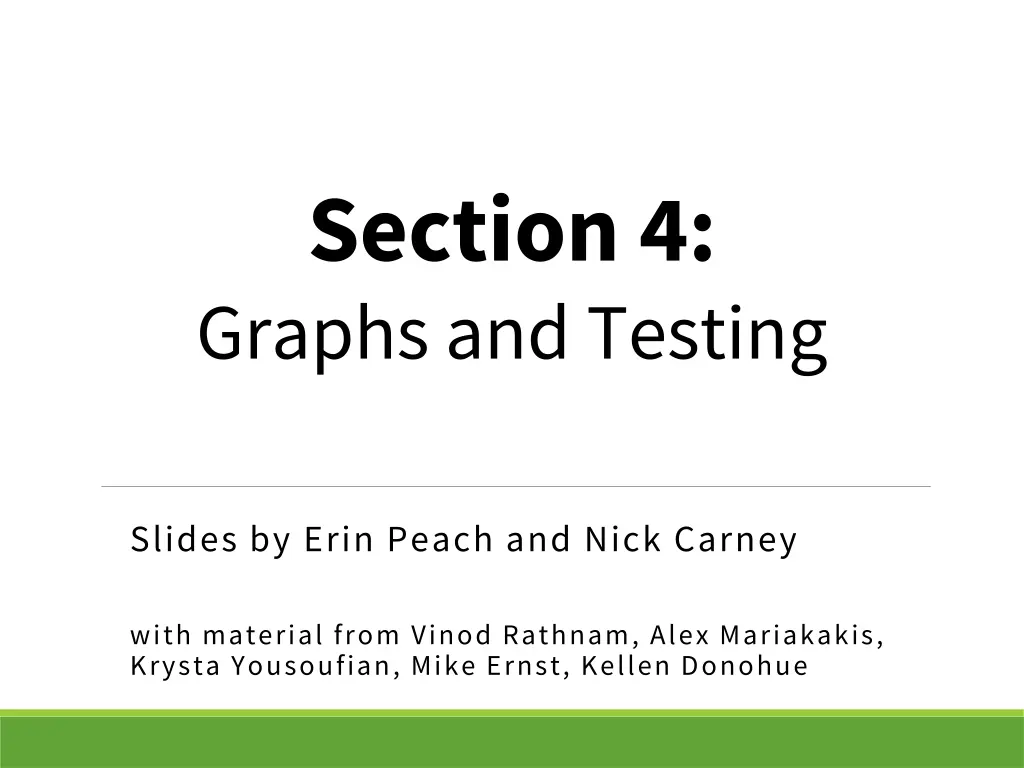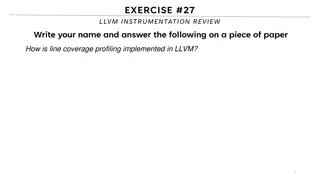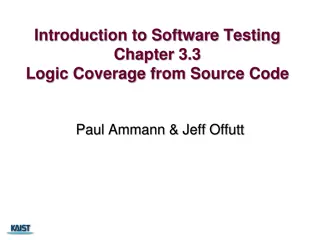
Graphs, Testing, and JUnit Essentials
Explore the fundamentals of graphs, JUnit testing, and internal vs. external testing in software development. Learn about graph structures, paths, JUnit test classes, using JUnit assertions, and more. Enhance your understanding of test scripts, API specifications, and implementation tests for robust software quality assurance.
Download Presentation

Please find below an Image/Link to download the presentation.
The content on the website is provided AS IS for your information and personal use only. It may not be sold, licensed, or shared on other websites without obtaining consent from the author. If you encounter any issues during the download, it is possible that the publisher has removed the file from their server.
You are allowed to download the files provided on this website for personal or commercial use, subject to the condition that they are used lawfully. All files are the property of their respective owners.
The content on the website is provided AS IS for your information and personal use only. It may not be sold, licensed, or shared on other websites without obtaining consent from the author.
E N D
Presentation Transcript
Section 4: Graphs and Testing Slides by Erin Peach and Nick Carney with material from Vinod Rathnam, Alex Mariakakis, Krysta Yousoufian, Mike Ernst, Kellen Donohue
AGENDA Graphs JUnit Testing Test Script Language JavaDoc Code coverage in eclipse (OPTIONAL)
GRAPHS B A Nodes and Edges C D E
GRAPHS B A Children of A C D E
GRAPHS B A Parents of D C D E
GRAPHS Paths from A to C: B A C D E
GRAPHS Paths from A to C: B A A -> C C D A -> D -> E -> C Shortest path from A to C? E
INTERNAL VS. EXTERNAL TESTING Internal : JUnit + How you decide to implement the object + Checked with implementation tests External: test script + Your API and specifications + Testing against the specification + Checked with specification tests
A JUNIT TEST CLASS A method with @Testis flagged as a JUnit test All @Testmethods run when JUnit runs import org.junit.*; import static org.junit.Assert.*; public class TestSuite { ... @Test public void TestName1() { ... } }
USING JUNIT ASSERTIONS Verifies that a value matches expectations assertEquals(42, meaningOfLife()); assertTrue(list.isEmpty()); If the assert fails: + Test immediately terminates + Other tests in the test class are still run as normal + Results show details of failed tests (We ll get to this later)
USING JUNIT ASSERTIONS Assertion assertTrue(test) assertFalse(test) assertEquals(expected, actual) assertSame(expected, actual) assertNotSame(expected, actual) assertNull(value) assertNotNull(value) Case for failure the boolean test is false the boolean test is true the values are not equal the values are not the same (by ==) the values are the same (by ==) the given value is not null the given value is null And others: http://www.junit.org/apidocs/org/junit/Assert.html Each method can also be passed a string to display if it fails: assertEquals("message", expected, actual)
CHECKING FOR EXCEPTIONS Verify that a method throws an exception when it should: Passes if specified exception is thrown, fails otherwise Only time it s OK to write a test without a form of asserts @Test(expected=IndexOutOfBoundsException.class) public void testGetEmptyList() { List<String> list = new ArrayList<String>(); list.get(0); }
But dont I need to create a list before checking if I ve successfully added to it?
SETUP AND TEARDOWN Methods to run before/after each test case method is called: @Before public void name() { ... } @After public void name() { ... } Methods to run once before/after the entire test class runs: @BeforeClass public static void name() { ... } @AfterClass public static void name() { ... }
SETUP AND TEARDOWN public class Example { List empty; @Before public void initialize() { empty = new ArrayList(); } @Test public void size() { ... } @Test public void remove() { ... } }
The Rules 1. Don t Repeat Yourself Use constants and helper methods 2. Be Descriptive Take advantage of message, expected, and actual values 3. Keep Tests Small Isolate bugs one at a time Test halts after failed assertion 4. Be Thorough Test big, small, boundaries, exceptions, errors
LETS PUT IT ALL TOGETHER! public class DateTest { ... // Test addDays when it causes a rollover between months @Test public void testAddDaysWrapToNextMonth() { Date actual = new Date(2050, 2, 15); actual.addDays(14); Date expected = new Date(2050, 3, 1); assertEquals("date after +14 days", expected, actual); }
How To Create JUnit Test Classes Right-click hw5.test -> New -> JUnit Test Case Important: Follow naming guidelines we provide Demo
JUNIT ASSERTS VS. JAVA ASSERTS We ve just been discussing JUnit assertions so far Java itself has assertions public class LitterBox { ArrayList<Kitten> kittens; public Kitten getKitten(int n) { assert(n >= 0); return kittens(n); } }
ASSERTIONS VS. EXCEPTIONS public class LitterBox { ArrayList<Kitten> kittens; public class LitterBox { ArrayList<Kitten> kittens; public Kitten getKitten(int n) { assert(n >= 0); return kittens(n); } public Kitten getKitten(int n) { try { return kittens(n); } catch(Exception e) { } } } } Assertions should check for things that should never happen Exceptions should check for things that might happen Exceptions address the robustness of your code, while assertions address its correctness
REMINDER: ENABLING ASSERTS IN ECLIPSE To enable asserts: Go to Run -> Run Configurations -> Arguments tab -> input -ea in VM arguments section Do this for every test file
Expensive CheckReps Ant Validate and Staff Grading will have assertions enabled But sometimes a checkRep can be expensive For example, looking at each node in a Graph with a large number of nodes This could cause the grading scripts to timeout
Expensive CheckReps Before your final commit, remove the checking of expensive parts of your checkRep or the checking of your checkRep entirely Example: boolean flag and structure your checkRep as so: private void checkRep() { cheap-stuff if(DEBUG_FLAG) { // or can have this for entire checkRep expensive-stuff } cheap-stuff ...
EXTERNAL TESTS: TEST SCRIPT LANGUAGE
TEST SCRIPT LANGUAGE Text file with one command listed per line First word is always the command name Remaining words are arguments Commands will correspond to methods in your code
TEST SCRIPT LANGUAGE (ex .test file) # Create a graph CreateGraph graph1 # Add a pair of nodes AddNode graph1 n1 AddNode graph1 n2 n1 n2 # Add an edge AddEdge graph1 n1 n2 e1 # Print the nodes in the graph and the outgoing edges from n1 ListNodes graph1 ListChildren graph1 n1
How To Create Specification Tests Create .test and .expected file pairs under hw5.test Implement parts of HW5TestDriver + driver connects commands from .test file to your Graph implementation to the output which is matched with .expected file Run all tests by running SpecificationTests.java + Note: staff will have our own .test and .expected pairs to run with your code + Do not hardcode .test/.expected pairs to pass, but instead make sure the format in hw5 instructions is correctly followed
JAVADOC API Now you can generate the JavaDocAPI for your code Instructions in the Editing/Compiling Handout Demo: Generate JavaDocs
Code coverage One measure of how well you ve tested your code Different kinds: Statements Branches Paths (see lecture slides on testing for more detail)
When is coverage knowledge useful? What if testInductiveCasewere missing from FibonacciTest.java and getFibTerm(intn) in Fibonacci.java were still returning the difference instead of the sum of previous terms? All tests pass, but code isn t correct!
Code Coverage in Eclipse EclEmma(Ecllike Eclipse) lets you visualize statementand branchcode coverage http://www.eclemma.org/installation.html The next couple slides will go over installation option 1
Installation Step 1 From eclipse, go to the Help menu, and then choose Eclipse Marketplace
Installation Step 2 Search for coverage, then when EclEmma Java Code Coverage shows up, click Install Then accept the license agreement, hit Finish, and restart Eclipse
Using it From the top bar, click the coverage arrow instead of the run arrow Or, right-click on a .java file and chose Coverage as instead of Run as (see next slide for screenshot)
What it looks like Basic idea: Highlights lines of code green(covered), yellow(partially covered missing some branch(es)), or red(no coverage) Also has a view at the bottom with percent of covered code, and you can expand folders and/or packages down to the individual file level Demo with hw3 Fibonacci.java and FibonacciTest.java
Questions to help explore the tool What happens if you run the coverage view after you comment out the @Test before testInductiveCasein FibonacciTest.java? What color(s) do the lines of that method turn? What color(s) do the lines of the method getFibTerm(intn) in FibonacciTest.java turn?
Shown by hovering the mouse pointer over the yellow line
So, coverage is Good for catching things like Missing @Test before a test method Finding branches/statements you re forgetting to test Bad for things like Making sure you test edge cases If original FibonacciTesthad only tested n=-1, n=1, and n=3, would have caught difference instead of sum bug, but might not have caught the edge/base case issues Making sure your tests make sense Good style Good choice of things to test Etc.
Final note This plugin is just a tool It can t test for you It is only one way of visualizing the tests you ve written It can be misleading It is optional If it doesn t make your life easier, don t use it






















